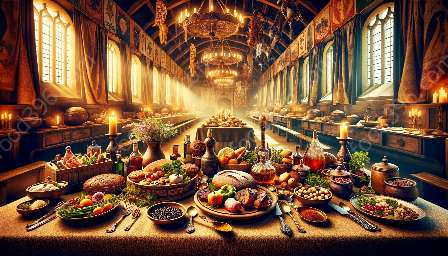Medieval banquet and feast culture holds a significant place in history, intertwining with the culinary arts and reflecting the social, cultural, and economic dynamics of the Middle Ages. The lavish feasts of the medieval period were not only about indulging in sumptuous food but also served as a means of displaying power, social hierarchy, and generosity. To truly understand the essence of medieval banquet and feast culture, it is crucial to delve into the history of medieval cuisine and culinary traditions of the era.
The History of Medieval Cuisine
The roots of medieval cuisine can be traced back to the early Middle Ages, characterized by a blend of Roman, Germanic, and Celtic culinary influences. With the decline of the Roman Empire, food production and distribution underwent significant changes, leading to the emergence of distinct regional culinary traditions across Europe. The period saw the proliferation of agricultural practices, advancements in culinary techniques, and the introduction of various ingredients such as spices, herbs, and exotic produce from the Far East through trade routes.
The Role of Banquets and Feasts in Medieval Society
Medieval banquets and feasts were more than just gatherings for communal dining; they were elaborate events that showcased the wealth, power, and hospitality of the hosts. Feasting became a symbol of social status and hierarchy, and the grandeur of these events often reflected the host’s ability to provide and share abundance. These occasions were characterized by an abundance of food, extravagant decorations, entertainment, and rituals that reflected the religious and cultural beliefs of the time.
Key Elements of Medieval Banquets and Feasts
The banquets and feasts of medieval Europe were known for their opulence and grandeur, with the use of luxurious tableware, intricate table settings, and an extensive array of dishes. The culinary repertoire during these events was a reflection of the social hierarchy, with exotic and rare ingredients reserved for the noble class, while the lower classes made do with simpler fare. The consumption of food during these events was guided by etiquette and chivalric codes, emphasizing manners, courtesy, and refinement in dining.
Feast Culture in Medieval Literature and Art
Medieval literature and art often depicted the opulence and significance of banquets and feasts. Epic tales, chivalric romances, and courtly literature frequently featured grand feasting scenes, portraying the elaborate settings, food offerings, and the social dynamics of these events. Furthermore, medieval art, including illuminated manuscripts and paintings, depicted banquet scenes as a means of capturing the essence of medieval culinary culture and the social structures associated with feasting.
Evolution of Medieval Feast Culture
Over the centuries, the culture of banquets and feasts underwent significant transformations, influenced by changes in social structures, culinary trends, and historical events. The impact of the Renaissance, the Age of Exploration, and the Reformation brought forth shifts in culinary practices and dining etiquette, thereby shaping the course of feast culture in the late medieval period and the early modern era.
Medieval banquet and feast culture remains an integral part of culinary history, offering profound insights into the social, cultural, and gastronomic aspects of the Middle Ages. By exploring the symbiotic relationship between medieval cuisine, banquet traditions, and societal customs, one can gain a deeper appreciation for the culinary heritage that has transcended centuries.

